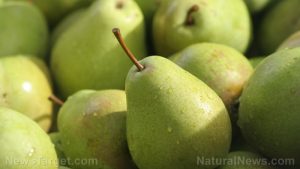
Ethoxyquin — toxicity, side effects, diseases and environmental impacts
Tuesday, December 05, 2017 by Zoey Sky
http://www.naturalpedia.com/ethoxyquin-toxicity-side-effects-diseases-and-environmental-impacts.html

Ethoxyquin is registered for use as an antioxidant to control scald, or browning, in pears. It is applied post-harvest by spraying/drenching, paper wrapping, or a combination of the two. There are currently only two formulation types registered for this chemical, which includes an emulsifiable concentrate (one product) and an impregnated wrap (three products).
Ethoxyquin was developed by Monsanto in the 1950s. Ethoxyquin was initially registered as a pesticide in 1965 as an antioxidant used as a deterrent of scald in pears through post-harvest indoor application via a drench and/or impregnated wrap. There are three companies, Decco, Ceraxagri, Inc., and Wrap Pack, Inc., who are ethoxyquin registrants.
Ethoxyquin appears as a clear light yellow to dark brown liquid. It discolors and stains badly, and ethoxyquin also has a Mercaptan-like odor. Ethoxyquin is a combustible chemical. It polymerizes and darkens in color when exposed to light and air. It is insoluble in water.
Ethoxyquin’s trade names and identifiers include:
- 91-53-2
- 6-Ethoxy-2,2,4-trimethyl-1,2-dihydroquinoline
- Ethoxyquine
- Santoquin
- Santoquine
- Niflex
- Antioxidant EC
- Santoflex A
- Santoflex AW
- Stop-Scald
- Dawe’s nutrigard
- Nix-Scald
- Nocrack AW
- Quinol ED
- Permanax 103
- Aries Antox
- Niflex D
- Antage AW
- Nocrac AW

List of known side effects
Ethoxyquin is harmful if swallowed, and exposure to the chemical can cause skin irritation along with eye irritation. Ethoxyquin can also cause skin sensitization (allergic reactions), lacrimation, depression, reproductive effects, liver effects, kidney effects, and thyroid effects. Dermatitis may also occur. Ethoxyquin is very toxic to aquatic life, with long-lasting effects.
Body systems affected by ethoxyquin
Tests in animals show that ethoxyquin has a weak sensitizing potential, and extensive human experience from the use of this chemical showed strong association with contact dermatitis that ceased upon discontinuation of working in an ethoxyquin environment.
The primary target organs affected by ethoxyquin in experimental animals are the liver and kidneys, and studies indicate that ethoxyquin is not a teratogen or a developmental toxicant in rats or rabbits.
While ethoxyquin has not been tested for its carcinogenic potential, a closely related chemical, 1,2-dihydro-2,2,4-trimethylquinoline, showed some evidence of carcinogenic activity in rats. The only suggestion of a potential carcinogenic effect for ethoxyquin came from a Manson et al. (1987) study.
Items that can contain ethoxyquin
Ethoxyquin is regulated by the Food and Drug Administration (FDA) for its use as a preservative in animal feed, dehydrated crops, and sorghum. It is also used as an antioxidant for the preservation of color in the production of chili powder, paprika, and ground chili. Ethoxyquin is also used as a post-harvest dip for apples and pears.
How to avoid ethoxyquin
Always wear proper protective gear when handling ethoxyquin.
- Respirator — Wear a Type A Filter of sufficient capacity, like AS/NZS (Standards Australia) 1716 & 1715, EN (European Standards) 1432000 & 1492001, ANSI (American National Standards Institute) Z88, or national equivalent.
- Eye — Safety glasses with side shields or a pair of chemical goggles can help protect your eyes. Contact lenses may pose a special hazard; soft contact lenses may absorb and concentrate irritants. A written policy document, describing the wearing of lens or restrictions on use, should be created for each workplace or task.
- Hands/feet — Wear chemical protective gloves, e.g. PVC (polyvinyl chloride). Wear safety footwear or safety gumboots, (e.g. Rubber).
- Other — Always wear overalls and PVC apron, and apply barrier cream and skin cleansing cream.
Where to learn more
- The best organic pet food brands revealed
- Commercial food is unhealthy for your pet
- Feeding Your Pet Treats Could Be Harmful – Give Them a Nutritional Bonus Instead
- Conventional kibble could be slowly killing your pets
- Former active US Marine demands GMO ban after curing debilitating health problems by switching to organic
Summary
Ethoxyquin is registered for use as an antioxidant to control scald (browning) in pears.
Ethoxyquin is harmful if swallowed, and exposure can cause skin irritation along with eye irritation.
Ethoxyquin is regulated by the FDA for its use as a preservative in animal feed, dehydrated crops, and sorghum.
Sources include:
Tagged Under: Tags: ethoxyquin





